University Nursing Assignment: Chronic Illness and Self-Management
VerifiedAdded on 2020/03/01
|9
|1928
|37
Report
AI Summary
This Bachelor of Nursing assignment report delves into the multifaceted aspects of chronic illness. It begins by defining chronicity and exploring various chronic diseases, including Alzheimer's, cardiac disease, and diabetes, and their causative factors. The report then examines the nursing perspective on managing chronic and complex illnesses, differentiating between disease and illness, and outlining a tiered approach to illness management. The report further discusses the benefits of self-management in chronic illness, emphasizing the importance of patient knowledge, healthy lifestyle choices, and community support. Additionally, the report introduces the chronic care model (CCM) as an organized approach to managing chronic illnesses, highlighting its core principles of change management and effective communication between patients and care providers. The report also addresses depression as a common comorbidity with chronic illnesses, discussing its impact on patients and the need for immediate care. Finally, the assignment provides a comprehensive overview of the subject matter, supported by relevant references.
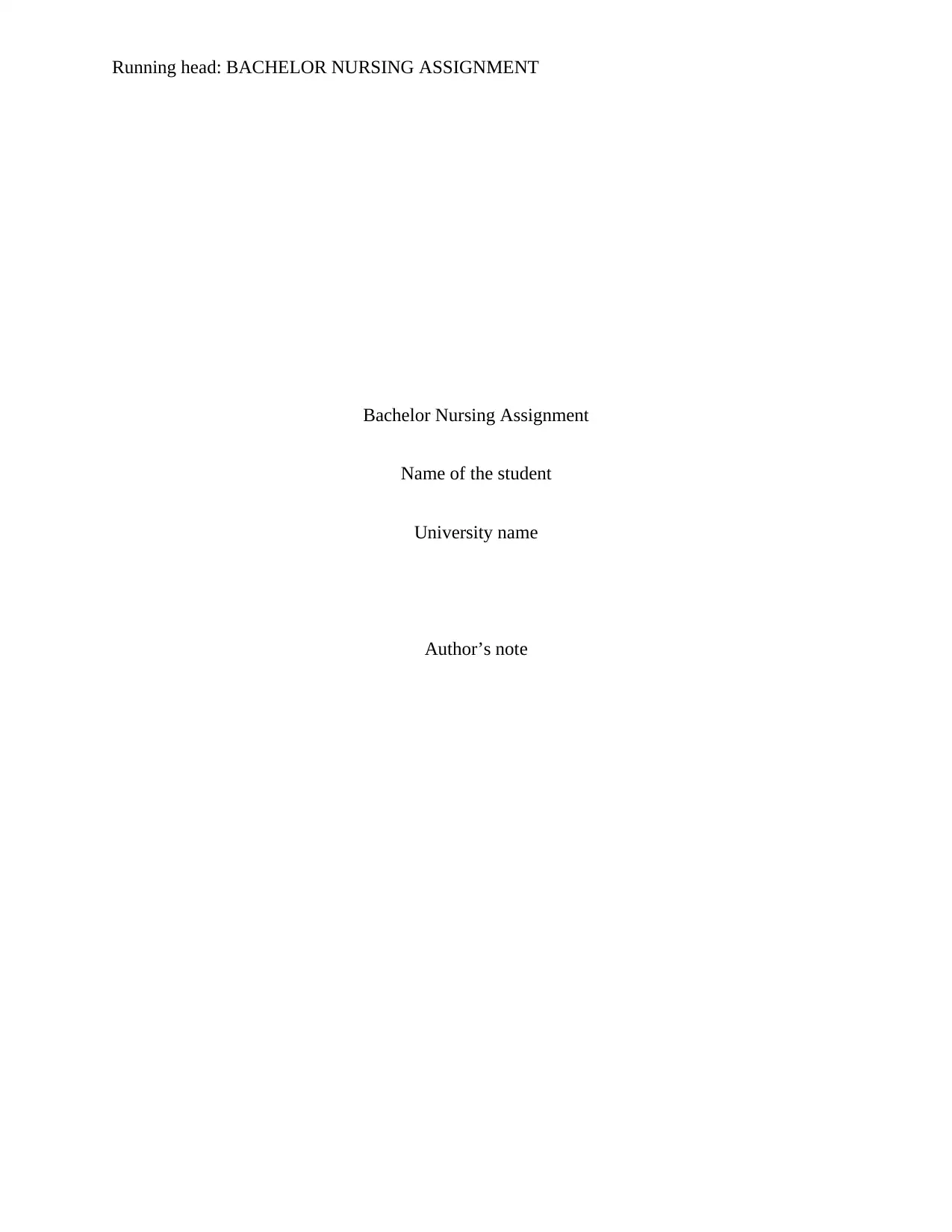
Running head: BACHELOR NURSING ASSIGNMENT
Bachelor Nursing Assignment
Name of the student
University name
Author’s note
Bachelor Nursing Assignment
Name of the student
University name
Author’s note
Paraphrase This Document
Need a fresh take? Get an instant paraphrase of this document with our AI Paraphraser
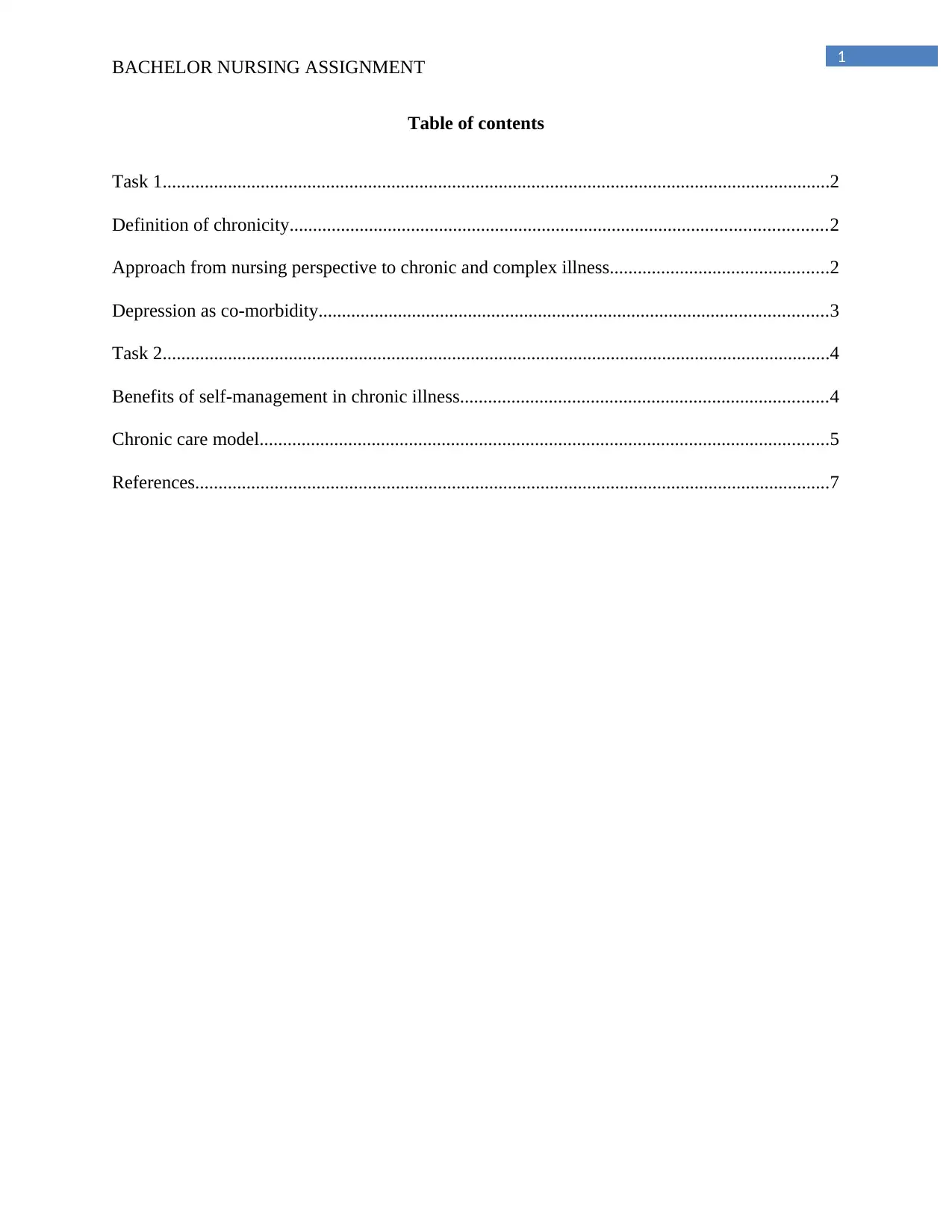
1
BACHELOR NURSING ASSIGNMENT
Table of contents
Task 1...............................................................................................................................................2
Definition of chronicity...................................................................................................................2
Approach from nursing perspective to chronic and complex illness...............................................2
Depression as co-morbidity.............................................................................................................3
Task 2...............................................................................................................................................4
Benefits of self-management in chronic illness...............................................................................4
Chronic care model..........................................................................................................................5
References........................................................................................................................................7
BACHELOR NURSING ASSIGNMENT
Table of contents
Task 1...............................................................................................................................................2
Definition of chronicity...................................................................................................................2
Approach from nursing perspective to chronic and complex illness...............................................2
Depression as co-morbidity.............................................................................................................3
Task 2...............................................................................................................................................4
Benefits of self-management in chronic illness...............................................................................4
Chronic care model..........................................................................................................................5
References........................................................................................................................................7
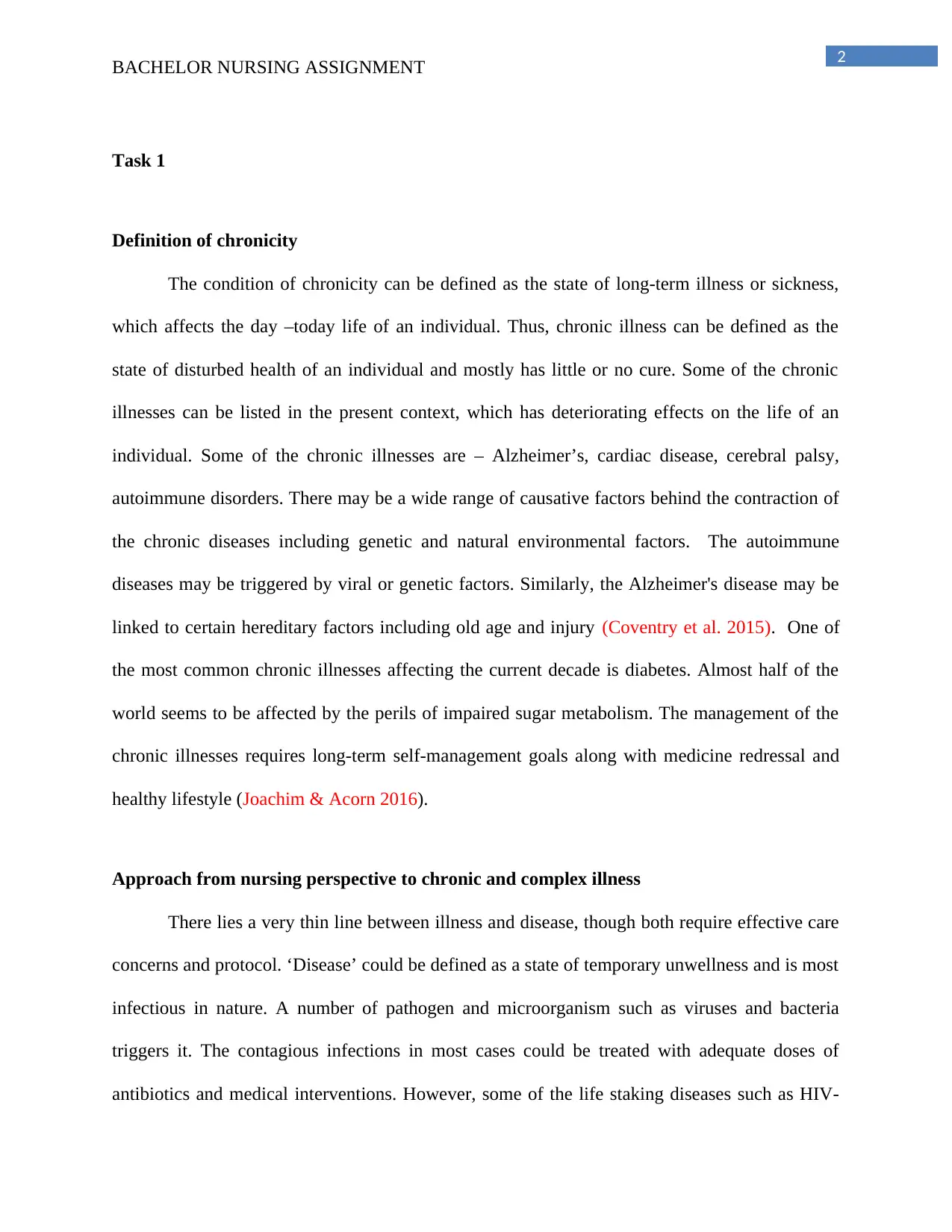
2
BACHELOR NURSING ASSIGNMENT
Task 1
Definition of chronicity
The condition of chronicity can be defined as the state of long-term illness or sickness,
which affects the day –today life of an individual. Thus, chronic illness can be defined as the
state of disturbed health of an individual and mostly has little or no cure. Some of the chronic
illnesses can be listed in the present context, which has deteriorating effects on the life of an
individual. Some of the chronic illnesses are – Alzheimer’s, cardiac disease, cerebral palsy,
autoimmune disorders. There may be a wide range of causative factors behind the contraction of
the chronic diseases including genetic and natural environmental factors. The autoimmune
diseases may be triggered by viral or genetic factors. Similarly, the Alzheimer's disease may be
linked to certain hereditary factors including old age and injury (Coventry et al. 2015). One of
the most common chronic illnesses affecting the current decade is diabetes. Almost half of the
world seems to be affected by the perils of impaired sugar metabolism. The management of the
chronic illnesses requires long-term self-management goals along with medicine redressal and
healthy lifestyle (Joachim & Acorn 2016).
Approach from nursing perspective to chronic and complex illness
There lies a very thin line between illness and disease, though both require effective care
concerns and protocol. ‘Disease’ could be defined as a state of temporary unwellness and is most
infectious in nature. A number of pathogen and microorganism such as viruses and bacteria
triggers it. The contagious infections in most cases could be treated with adequate doses of
antibiotics and medical interventions. However, some of the life staking diseases such as HIV-
BACHELOR NURSING ASSIGNMENT
Task 1
Definition of chronicity
The condition of chronicity can be defined as the state of long-term illness or sickness,
which affects the day –today life of an individual. Thus, chronic illness can be defined as the
state of disturbed health of an individual and mostly has little or no cure. Some of the chronic
illnesses can be listed in the present context, which has deteriorating effects on the life of an
individual. Some of the chronic illnesses are – Alzheimer’s, cardiac disease, cerebral palsy,
autoimmune disorders. There may be a wide range of causative factors behind the contraction of
the chronic diseases including genetic and natural environmental factors. The autoimmune
diseases may be triggered by viral or genetic factors. Similarly, the Alzheimer's disease may be
linked to certain hereditary factors including old age and injury (Coventry et al. 2015). One of
the most common chronic illnesses affecting the current decade is diabetes. Almost half of the
world seems to be affected by the perils of impaired sugar metabolism. The management of the
chronic illnesses requires long-term self-management goals along with medicine redressal and
healthy lifestyle (Joachim & Acorn 2016).
Approach from nursing perspective to chronic and complex illness
There lies a very thin line between illness and disease, though both require effective care
concerns and protocol. ‘Disease’ could be defined as a state of temporary unwellness and is most
infectious in nature. A number of pathogen and microorganism such as viruses and bacteria
triggers it. The contagious infections in most cases could be treated with adequate doses of
antibiotics and medical interventions. However, some of the life staking diseases such as HIV-
⊘ This is a preview!⊘
Do you want full access?
Subscribe today to unlock all pages.

Trusted by 1+ million students worldwide
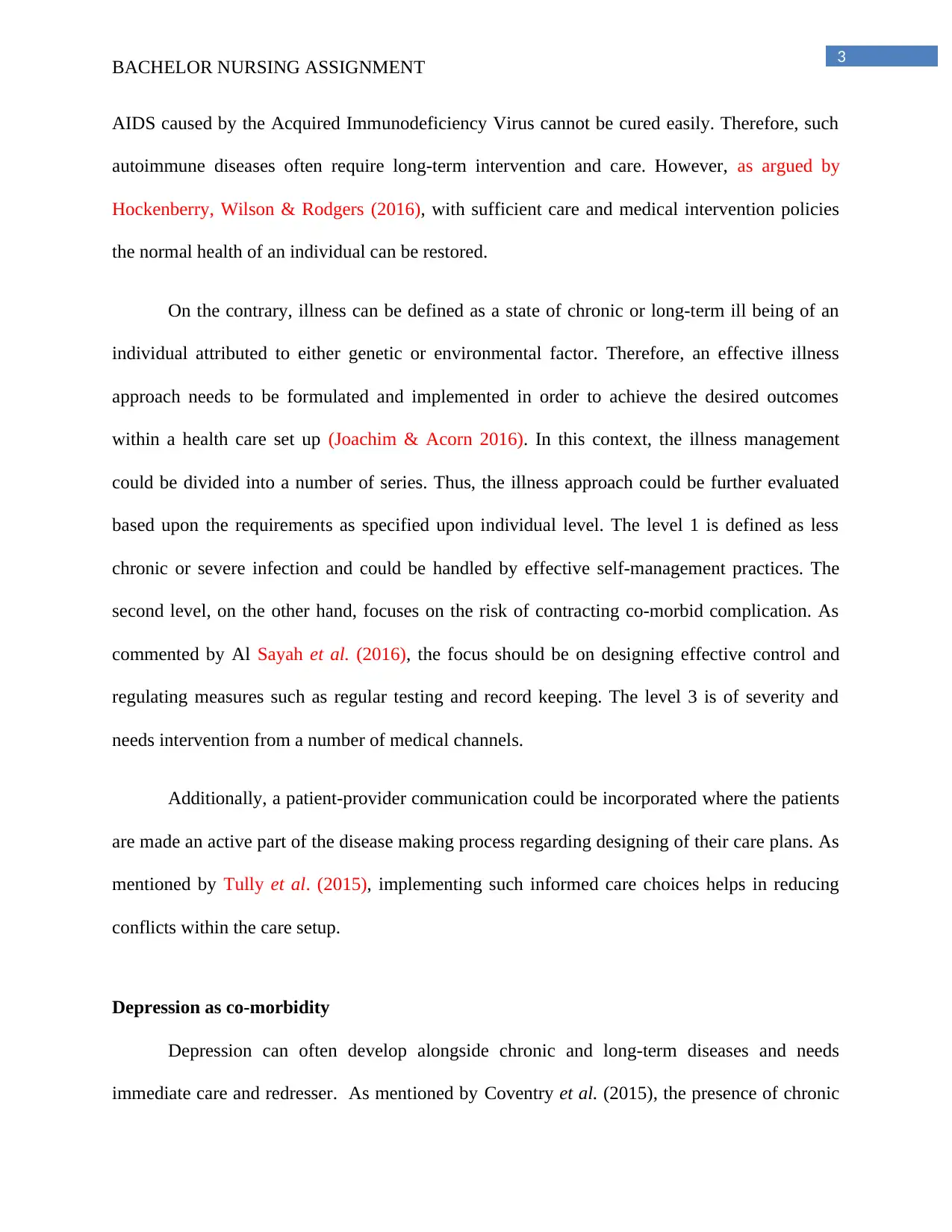
3
BACHELOR NURSING ASSIGNMENT
AIDS caused by the Acquired Immunodeficiency Virus cannot be cured easily. Therefore, such
autoimmune diseases often require long-term intervention and care. However, as argued by
Hockenberry, Wilson & Rodgers (2016), with sufficient care and medical intervention policies
the normal health of an individual can be restored.
On the contrary, illness can be defined as a state of chronic or long-term ill being of an
individual attributed to either genetic or environmental factor. Therefore, an effective illness
approach needs to be formulated and implemented in order to achieve the desired outcomes
within a health care set up (Joachim & Acorn 2016). In this context, the illness management
could be divided into a number of series. Thus, the illness approach could be further evaluated
based upon the requirements as specified upon individual level. The level 1 is defined as less
chronic or severe infection and could be handled by effective self-management practices. The
second level, on the other hand, focuses on the risk of contracting co-morbid complication. As
commented by Al Sayah et al. (2016), the focus should be on designing effective control and
regulating measures such as regular testing and record keeping. The level 3 is of severity and
needs intervention from a number of medical channels.
Additionally, a patient-provider communication could be incorporated where the patients
are made an active part of the disease making process regarding designing of their care plans. As
mentioned by Tully et al. (2015), implementing such informed care choices helps in reducing
conflicts within the care setup.
Depression as co-morbidity
Depression can often develop alongside chronic and long-term diseases and needs
immediate care and redresser. As mentioned by Coventry et al. (2015), the presence of chronic
BACHELOR NURSING ASSIGNMENT
AIDS caused by the Acquired Immunodeficiency Virus cannot be cured easily. Therefore, such
autoimmune diseases often require long-term intervention and care. However, as argued by
Hockenberry, Wilson & Rodgers (2016), with sufficient care and medical intervention policies
the normal health of an individual can be restored.
On the contrary, illness can be defined as a state of chronic or long-term ill being of an
individual attributed to either genetic or environmental factor. Therefore, an effective illness
approach needs to be formulated and implemented in order to achieve the desired outcomes
within a health care set up (Joachim & Acorn 2016). In this context, the illness management
could be divided into a number of series. Thus, the illness approach could be further evaluated
based upon the requirements as specified upon individual level. The level 1 is defined as less
chronic or severe infection and could be handled by effective self-management practices. The
second level, on the other hand, focuses on the risk of contracting co-morbid complication. As
commented by Al Sayah et al. (2016), the focus should be on designing effective control and
regulating measures such as regular testing and record keeping. The level 3 is of severity and
needs intervention from a number of medical channels.
Additionally, a patient-provider communication could be incorporated where the patients
are made an active part of the disease making process regarding designing of their care plans. As
mentioned by Tully et al. (2015), implementing such informed care choices helps in reducing
conflicts within the care setup.
Depression as co-morbidity
Depression can often develop alongside chronic and long-term diseases and needs
immediate care and redresser. As mentioned by Coventry et al. (2015), the presence of chronic
Paraphrase This Document
Need a fresh take? Get an instant paraphrase of this document with our AI Paraphraser
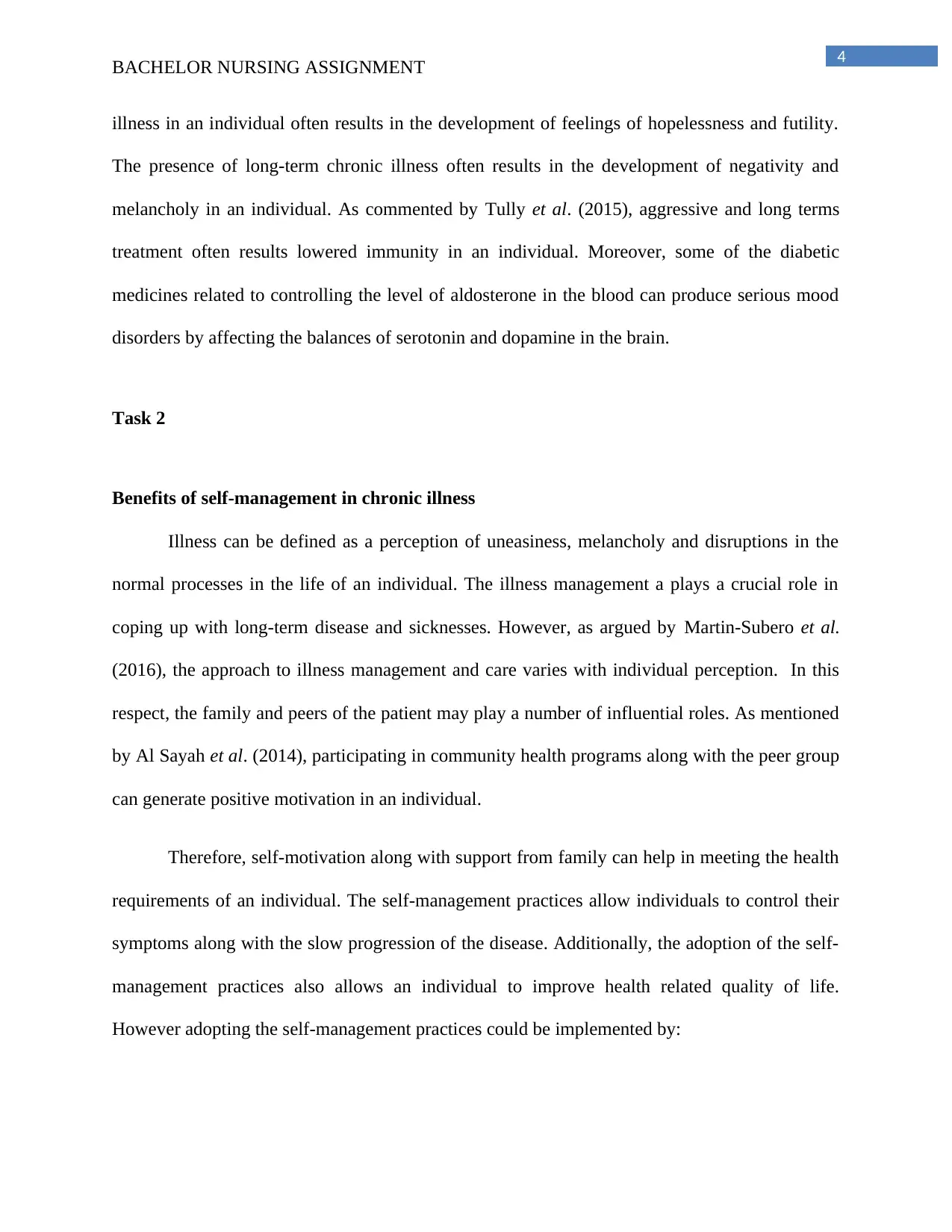
4
BACHELOR NURSING ASSIGNMENT
illness in an individual often results in the development of feelings of hopelessness and futility.
The presence of long-term chronic illness often results in the development of negativity and
melancholy in an individual. As commented by Tully et al. (2015), aggressive and long terms
treatment often results lowered immunity in an individual. Moreover, some of the diabetic
medicines related to controlling the level of aldosterone in the blood can produce serious mood
disorders by affecting the balances of serotonin and dopamine in the brain.
Task 2
Benefits of self-management in chronic illness
Illness can be defined as a perception of uneasiness, melancholy and disruptions in the
normal processes in the life of an individual. The illness management a plays a crucial role in
coping up with long-term disease and sicknesses. However, as argued by Martin-Subero et al.
(2016), the approach to illness management and care varies with individual perception. In this
respect, the family and peers of the patient may play a number of influential roles. As mentioned
by Al Sayah et al. (2014), participating in community health programs along with the peer group
can generate positive motivation in an individual.
Therefore, self-motivation along with support from family can help in meeting the health
requirements of an individual. The self-management practices allow individuals to control their
symptoms along with the slow progression of the disease. Additionally, the adoption of the self-
management practices also allows an individual to improve health related quality of life.
However adopting the self-management practices could be implemented by:
BACHELOR NURSING ASSIGNMENT
illness in an individual often results in the development of feelings of hopelessness and futility.
The presence of long-term chronic illness often results in the development of negativity and
melancholy in an individual. As commented by Tully et al. (2015), aggressive and long terms
treatment often results lowered immunity in an individual. Moreover, some of the diabetic
medicines related to controlling the level of aldosterone in the blood can produce serious mood
disorders by affecting the balances of serotonin and dopamine in the brain.
Task 2
Benefits of self-management in chronic illness
Illness can be defined as a perception of uneasiness, melancholy and disruptions in the
normal processes in the life of an individual. The illness management a plays a crucial role in
coping up with long-term disease and sicknesses. However, as argued by Martin-Subero et al.
(2016), the approach to illness management and care varies with individual perception. In this
respect, the family and peers of the patient may play a number of influential roles. As mentioned
by Al Sayah et al. (2014), participating in community health programs along with the peer group
can generate positive motivation in an individual.
Therefore, self-motivation along with support from family can help in meeting the health
requirements of an individual. The self-management practices allow individuals to control their
symptoms along with the slow progression of the disease. Additionally, the adoption of the self-
management practices also allows an individual to improve health related quality of life.
However adopting the self-management practices could be implemented by:
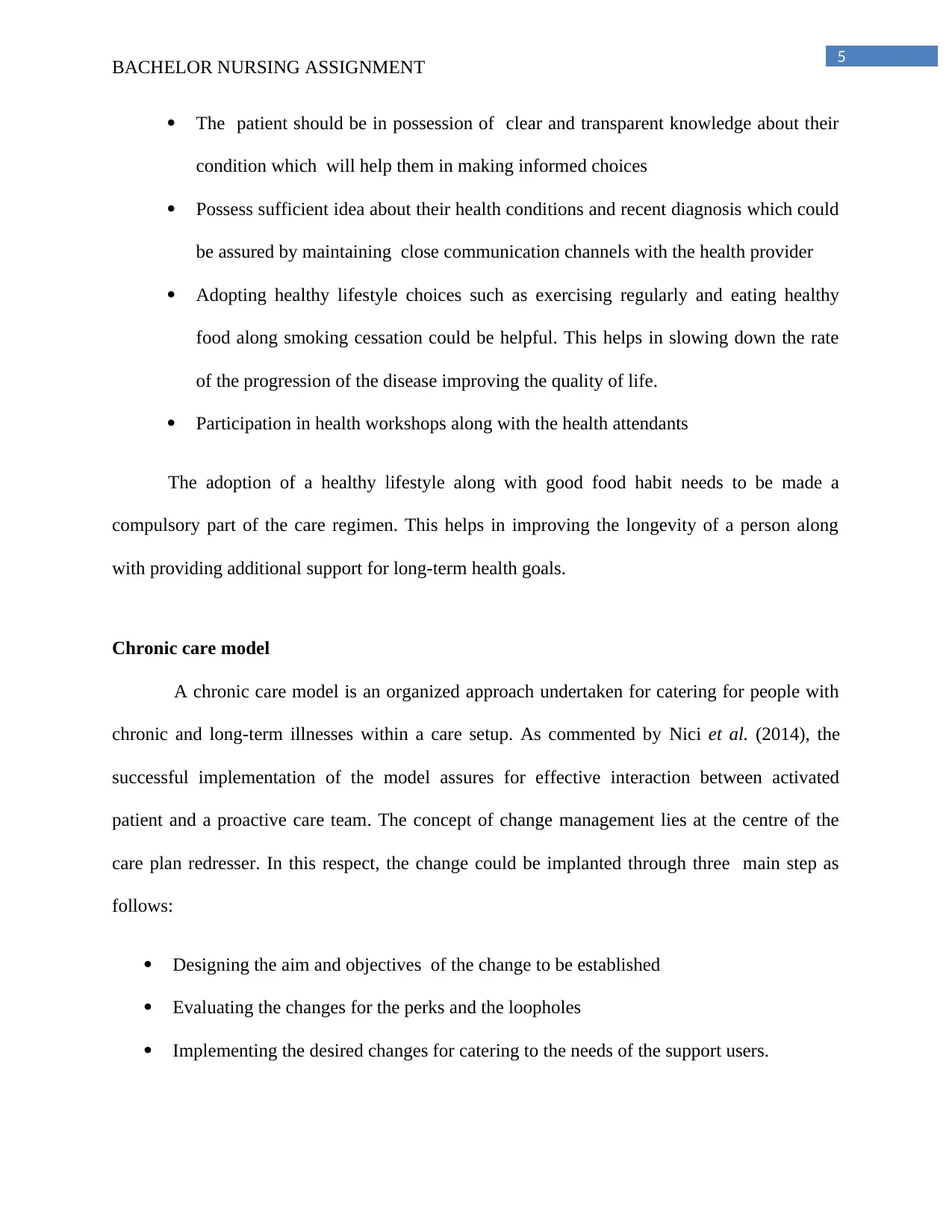
5
BACHELOR NURSING ASSIGNMENT
The patient should be in possession of clear and transparent knowledge about their
condition which will help them in making informed choices
Possess sufficient idea about their health conditions and recent diagnosis which could
be assured by maintaining close communication channels with the health provider
Adopting healthy lifestyle choices such as exercising regularly and eating healthy
food along smoking cessation could be helpful. This helps in slowing down the rate
of the progression of the disease improving the quality of life.
Participation in health workshops along with the health attendants
The adoption of a healthy lifestyle along with good food habit needs to be made a
compulsory part of the care regimen. This helps in improving the longevity of a person along
with providing additional support for long-term health goals.
Chronic care model
A chronic care model is an organized approach undertaken for catering for people with
chronic and long-term illnesses within a care setup. As commented by Nici et al. (2014), the
successful implementation of the model assures for effective interaction between activated
patient and a proactive care team. The concept of change management lies at the centre of the
care plan redresser. In this respect, the change could be implanted through three main step as
follows:
Designing the aim and objectives of the change to be established
Evaluating the changes for the perks and the loopholes
Implementing the desired changes for catering to the needs of the support users.
BACHELOR NURSING ASSIGNMENT
The patient should be in possession of clear and transparent knowledge about their
condition which will help them in making informed choices
Possess sufficient idea about their health conditions and recent diagnosis which could
be assured by maintaining close communication channels with the health provider
Adopting healthy lifestyle choices such as exercising regularly and eating healthy
food along smoking cessation could be helpful. This helps in slowing down the rate
of the progression of the disease improving the quality of life.
Participation in health workshops along with the health attendants
The adoption of a healthy lifestyle along with good food habit needs to be made a
compulsory part of the care regimen. This helps in improving the longevity of a person along
with providing additional support for long-term health goals.
Chronic care model
A chronic care model is an organized approach undertaken for catering for people with
chronic and long-term illnesses within a care setup. As commented by Nici et al. (2014), the
successful implementation of the model assures for effective interaction between activated
patient and a proactive care team. The concept of change management lies at the centre of the
care plan redresser. In this respect, the change could be implanted through three main step as
follows:
Designing the aim and objectives of the change to be established
Evaluating the changes for the perks and the loopholes
Implementing the desired changes for catering to the needs of the support users.
⊘ This is a preview!⊘
Do you want full access?
Subscribe today to unlock all pages.

Trusted by 1+ million students worldwide
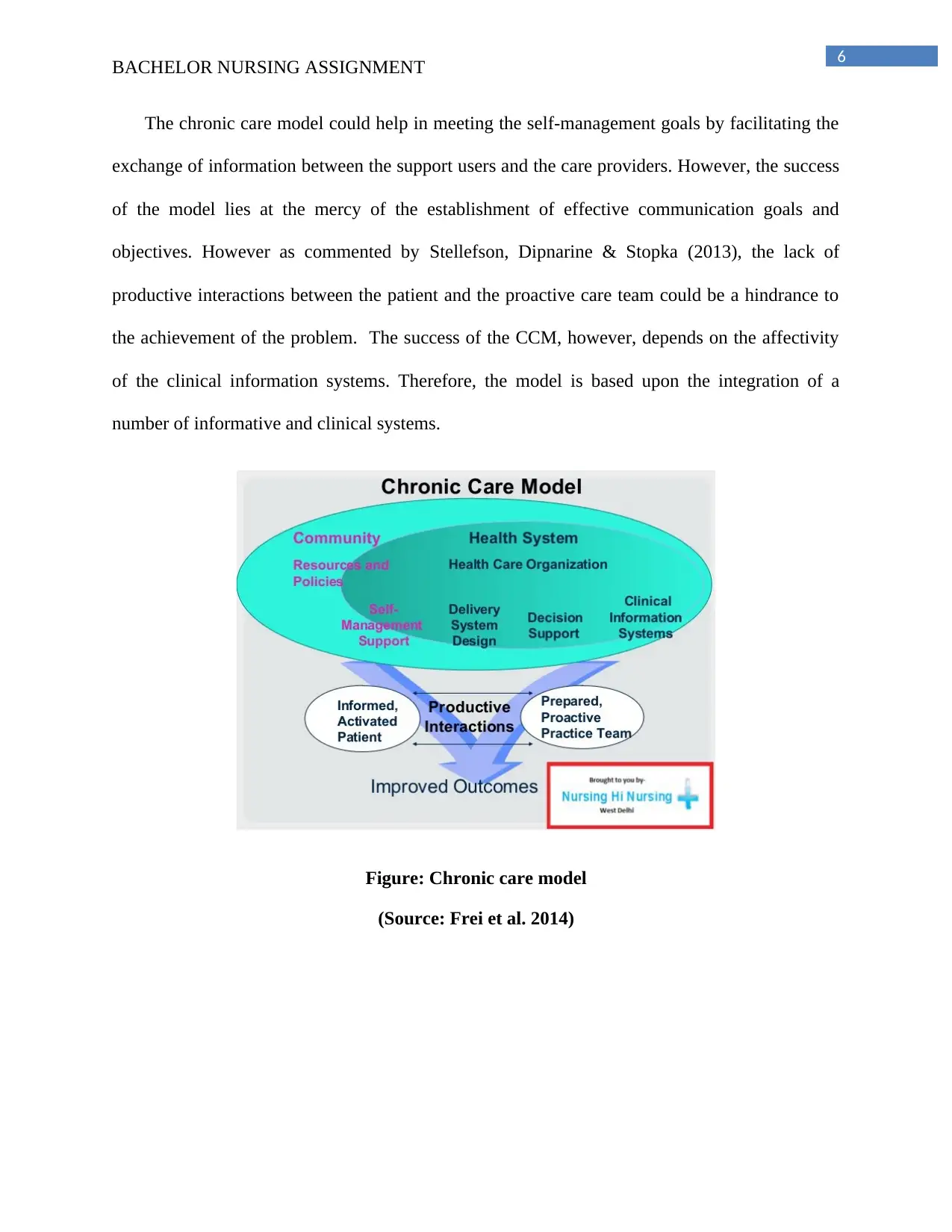
6
BACHELOR NURSING ASSIGNMENT
The chronic care model could help in meeting the self-management goals by facilitating the
exchange of information between the support users and the care providers. However, the success
of the model lies at the mercy of the establishment of effective communication goals and
objectives. However as commented by Stellefson, Dipnarine & Stopka (2013), the lack of
productive interactions between the patient and the proactive care team could be a hindrance to
the achievement of the problem. The success of the CCM, however, depends on the affectivity
of the clinical information systems. Therefore, the model is based upon the integration of a
number of informative and clinical systems.
Figure: Chronic care model
(Source: Frei et al. 2014)
BACHELOR NURSING ASSIGNMENT
The chronic care model could help in meeting the self-management goals by facilitating the
exchange of information between the support users and the care providers. However, the success
of the model lies at the mercy of the establishment of effective communication goals and
objectives. However as commented by Stellefson, Dipnarine & Stopka (2013), the lack of
productive interactions between the patient and the proactive care team could be a hindrance to
the achievement of the problem. The success of the CCM, however, depends on the affectivity
of the clinical information systems. Therefore, the model is based upon the integration of a
number of informative and clinical systems.
Figure: Chronic care model
(Source: Frei et al. 2014)
Paraphrase This Document
Need a fresh take? Get an instant paraphrase of this document with our AI Paraphraser
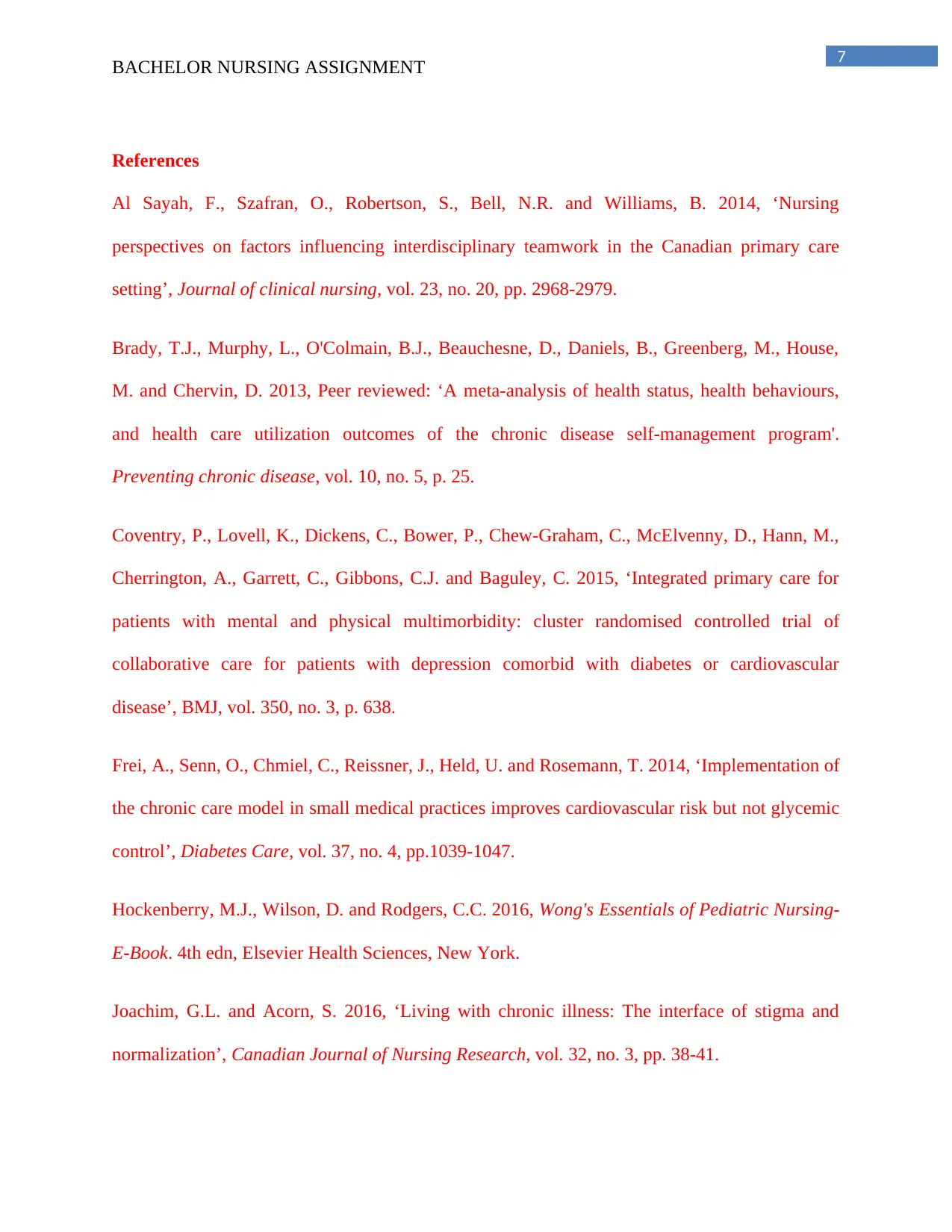
7
BACHELOR NURSING ASSIGNMENT
References
Al Sayah, F., Szafran, O., Robertson, S., Bell, N.R. and Williams, B. 2014, ‘Nursing
perspectives on factors influencing interdisciplinary teamwork in the Canadian primary care
setting’, Journal of clinical nursing, vol. 23, no. 20, pp. 2968-2979.
Brady, T.J., Murphy, L., O'Colmain, B.J., Beauchesne, D., Daniels, B., Greenberg, M., House,
M. and Chervin, D. 2013, Peer reviewed: ‘A meta-analysis of health status, health behaviours,
and health care utilization outcomes of the chronic disease self-management program'.
Preventing chronic disease, vol. 10, no. 5, p. 25.
Coventry, P., Lovell, K., Dickens, C., Bower, P., Chew-Graham, C., McElvenny, D., Hann, M.,
Cherrington, A., Garrett, C., Gibbons, C.J. and Baguley, C. 2015, ‘Integrated primary care for
patients with mental and physical multimorbidity: cluster randomised controlled trial of
collaborative care for patients with depression comorbid with diabetes or cardiovascular
disease’, BMJ, vol. 350, no. 3, p. 638.
Frei, A., Senn, O., Chmiel, C., Reissner, J., Held, U. and Rosemann, T. 2014, ‘Implementation of
the chronic care model in small medical practices improves cardiovascular risk but not glycemic
control’, Diabetes Care, vol. 37, no. 4, pp.1039-1047.
Hockenberry, M.J., Wilson, D. and Rodgers, C.C. 2016, Wong's Essentials of Pediatric Nursing-
E-Book. 4th edn, Elsevier Health Sciences, New York.
Joachim, G.L. and Acorn, S. 2016, ‘Living with chronic illness: The interface of stigma and
normalization’, Canadian Journal of Nursing Research, vol. 32, no. 3, pp. 38-41.
BACHELOR NURSING ASSIGNMENT
References
Al Sayah, F., Szafran, O., Robertson, S., Bell, N.R. and Williams, B. 2014, ‘Nursing
perspectives on factors influencing interdisciplinary teamwork in the Canadian primary care
setting’, Journal of clinical nursing, vol. 23, no. 20, pp. 2968-2979.
Brady, T.J., Murphy, L., O'Colmain, B.J., Beauchesne, D., Daniels, B., Greenberg, M., House,
M. and Chervin, D. 2013, Peer reviewed: ‘A meta-analysis of health status, health behaviours,
and health care utilization outcomes of the chronic disease self-management program'.
Preventing chronic disease, vol. 10, no. 5, p. 25.
Coventry, P., Lovell, K., Dickens, C., Bower, P., Chew-Graham, C., McElvenny, D., Hann, M.,
Cherrington, A., Garrett, C., Gibbons, C.J. and Baguley, C. 2015, ‘Integrated primary care for
patients with mental and physical multimorbidity: cluster randomised controlled trial of
collaborative care for patients with depression comorbid with diabetes or cardiovascular
disease’, BMJ, vol. 350, no. 3, p. 638.
Frei, A., Senn, O., Chmiel, C., Reissner, J., Held, U. and Rosemann, T. 2014, ‘Implementation of
the chronic care model in small medical practices improves cardiovascular risk but not glycemic
control’, Diabetes Care, vol. 37, no. 4, pp.1039-1047.
Hockenberry, M.J., Wilson, D. and Rodgers, C.C. 2016, Wong's Essentials of Pediatric Nursing-
E-Book. 4th edn, Elsevier Health Sciences, New York.
Joachim, G.L. and Acorn, S. 2016, ‘Living with chronic illness: The interface of stigma and
normalization’, Canadian Journal of Nursing Research, vol. 32, no. 3, pp. 38-41.
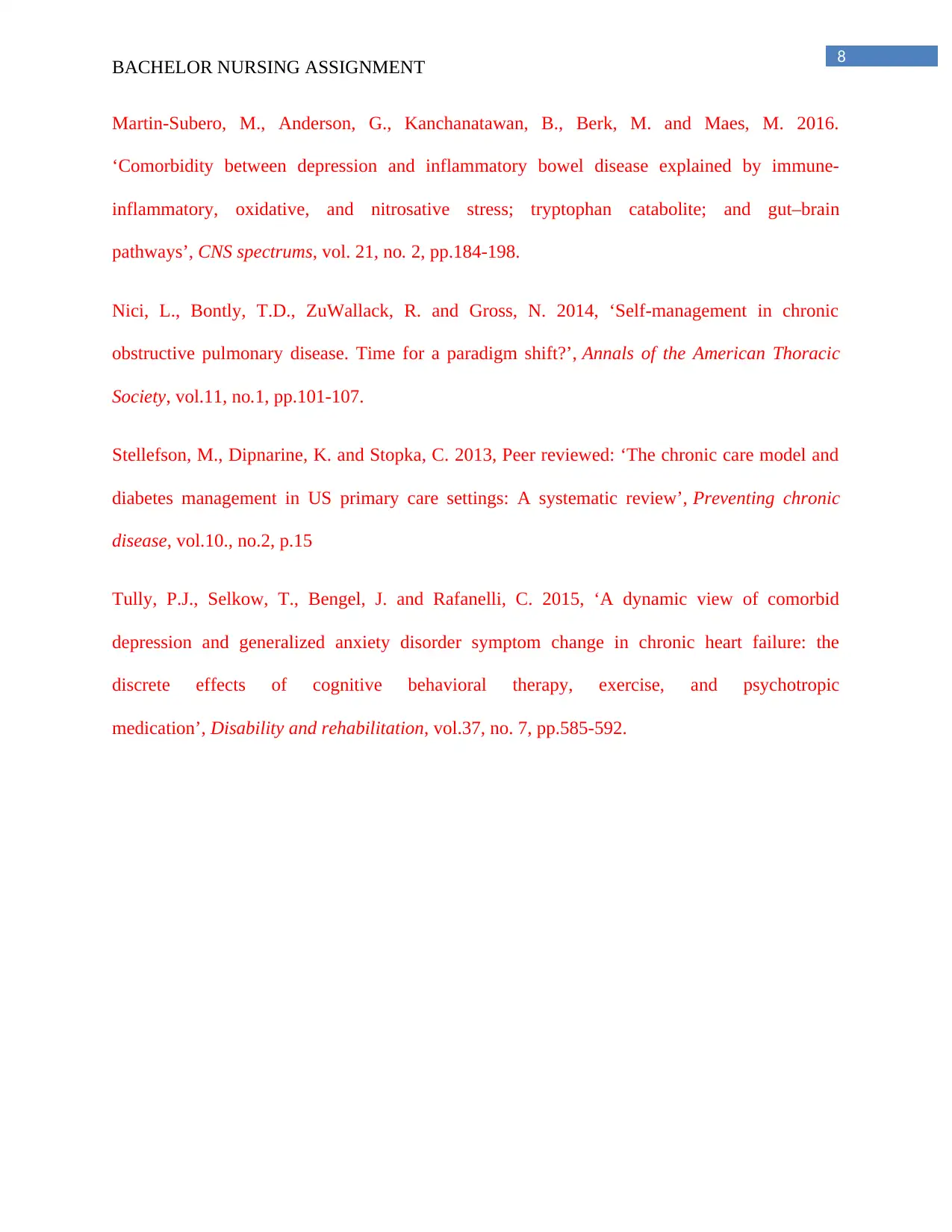
8
BACHELOR NURSING ASSIGNMENT
Martin-Subero, M., Anderson, G., Kanchanatawan, B., Berk, M. and Maes, M. 2016.
‘Comorbidity between depression and inflammatory bowel disease explained by immune-
inflammatory, oxidative, and nitrosative stress; tryptophan catabolite; and gut–brain
pathways’, CNS spectrums, vol. 21, no. 2, pp.184-198.
Nici, L., Bontly, T.D., ZuWallack, R. and Gross, N. 2014, ‘Self-management in chronic
obstructive pulmonary disease. Time for a paradigm shift?’, Annals of the American Thoracic
Society, vol.11, no.1, pp.101-107.
Stellefson, M., Dipnarine, K. and Stopka, C. 2013, Peer reviewed: ‘The chronic care model and
diabetes management in US primary care settings: A systematic review’, Preventing chronic
disease, vol.10., no.2, p.15
Tully, P.J., Selkow, T., Bengel, J. and Rafanelli, C. 2015, ‘A dynamic view of comorbid
depression and generalized anxiety disorder symptom change in chronic heart failure: the
discrete effects of cognitive behavioral therapy, exercise, and psychotropic
medication’, Disability and rehabilitation, vol.37, no. 7, pp.585-592.
BACHELOR NURSING ASSIGNMENT
Martin-Subero, M., Anderson, G., Kanchanatawan, B., Berk, M. and Maes, M. 2016.
‘Comorbidity between depression and inflammatory bowel disease explained by immune-
inflammatory, oxidative, and nitrosative stress; tryptophan catabolite; and gut–brain
pathways’, CNS spectrums, vol. 21, no. 2, pp.184-198.
Nici, L., Bontly, T.D., ZuWallack, R. and Gross, N. 2014, ‘Self-management in chronic
obstructive pulmonary disease. Time for a paradigm shift?’, Annals of the American Thoracic
Society, vol.11, no.1, pp.101-107.
Stellefson, M., Dipnarine, K. and Stopka, C. 2013, Peer reviewed: ‘The chronic care model and
diabetes management in US primary care settings: A systematic review’, Preventing chronic
disease, vol.10., no.2, p.15
Tully, P.J., Selkow, T., Bengel, J. and Rafanelli, C. 2015, ‘A dynamic view of comorbid
depression and generalized anxiety disorder symptom change in chronic heart failure: the
discrete effects of cognitive behavioral therapy, exercise, and psychotropic
medication’, Disability and rehabilitation, vol.37, no. 7, pp.585-592.
⊘ This is a preview!⊘
Do you want full access?
Subscribe today to unlock all pages.

Trusted by 1+ million students worldwide
1 out of 9
Related Documents
Your All-in-One AI-Powered Toolkit for Academic Success.
+13062052269
info@desklib.com
Available 24*7 on WhatsApp / Email
![[object Object]](/_next/static/media/star-bottom.7253800d.svg)
Unlock your academic potential
Copyright © 2020–2025 A2Z Services. All Rights Reserved. Developed and managed by ZUCOL.




